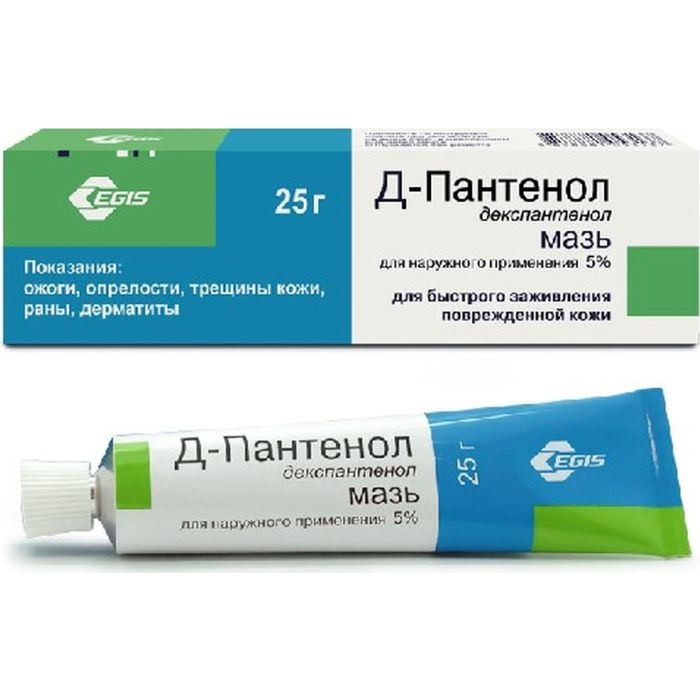D-Panthenol ointment for external use. approx. 5% tube 25g
Category
Wound healing
,
Scarring
,
Regenerating agents
Scope of the drug
Leather
Release form
Ointment
Manufacturer country
Croatia
Package quantity, pcs
one
Release form, composition and packaging
Ointment for external use 5% homogeneous, light yellow in color, with a characteristic lanolin odor.
1 g
dexpanthenol
50 mg
phenonip - 4 mg, lanolin - 160 mg, white beeswax - 50 mg, white soft paraffin - 210.8 mg, dimethicone - 5 mg, LANETTE SX emulsifier - 20 mg, propylene glycol - 20 mg, butylhydroxyanisole - 0.1 mg, butylhydroxytoluene - 0.1 mg , decamethylcyclopentasiloxane - 20 mg, magnesium sulfate heptahydrate - 5 mg, Protegin B - 295 mg, purified water - 160 mg.
25 g - aluminum tubes (1) - cardboard packs.
50 g - aluminum tubes (1) - packs of cardboard. Pharmacological action Dexpanthenol is a derivative of pantothenic acid, which is a component of coenzyme A and is involved in the processes of acetylation, carbohydrate and fat metabolism, the synthesis of acetylcholine, steroid hormones, porphyrins.
Stimulates skin regeneration, normalizes cellular metabolism, accelerates mitosis and increases the strength of collagen fibers.
It has a regenerating, metabolic and mild anti-inflammatory effect.
An increase in the need for pantothenic acid is noted with damage to the skin or tissues, in this case, the local deficiency of pantothenic acid can be replenished by local application of the drug D-Panthenol.
The excipients that make up the D-panthenol cream improve its properties. Pharmacokinetics The low molecular weight of dexpanthenol, hydrophilicity and low polarity make it possible for the active substances to penetrate into all layers of the skin.
When applied topically, it is rapidly absorbed and converted into pantothenic acid, binds to plasma proteins (mainly beta-globulin and albumin).
mild skin damage caused by mechanical, chemical, temperature and other factors:
- scratches, abrasions
- irritation after exposure to ultraviolet (including solar) and X-ray radiation
- burns of various origins (including sunburn)
- dermatitis
prevention and treatment of mild diaper dermatitis in young children
prevention and treatment of cracks in the nipples of the mammary glands in nursing mothers
protection of the skin from the effects of adverse climatic factors (chapping and frostbite)
prevention and treatment of mild diaper rash in children and adults
treatment of the skin around the tracheostomy, gastrostomy and colostomy.
Ointment
dry skin
wounds and burns of various origins (including solar), scratches, abrasions
bedsores
trophic ulcers of the lower extremities
dermatitis
boils after opening and sanitation
poorly healing skin grafts, aseptic postoperative wounds
skin care around the tracheostomy, gastrostomy and colostomy
treatment and prevention of cracks and inflammation of the nipples of the mammary gland during lactation
treatment and prevention of the consequences of adverse effects on the skin of environmental factors (cold, wind, dampness)
nursing infants:
- prevention and treatment of diaper rash
- activation of the healing process of the skin with minor injuries, diaper dermatitis, erythema from diapers, scratches and minor irritation after exposure to the sun, ultraviolet and x-ray radiation. Contraindications to use Hypersensitivity to the drug components. Dosage regimen Apply a thin layer of cream or ointment to the affected area, rubbing slightly , 2-4 times / day (more often if necessary).
If applied to an infected skin surface, it should be pre-treated with an antiseptic.
Breastfeeding mothers lubricate the nipple with ointment after each feeding.
Infants (including newborns)
Name ENG
D-PANTHENOL
Clinical and pharmacological group
A drug that improves trophism and tissue regeneration, for external use
ATX code
Dexpanthenol
Dosage
5% x 25g
Structure
1 g of ointment contains: Active substance: dexpanthenol - 50 mg.
Excipients: phenonip - 4 mg, lanolin - 160 mg, white beeswax - 50 mg, white soft paraffin - 210.8 mg, dimethicone - 5 mg, LANETTE SX emulsifier - 20 mg, propylene glycol - 20 mg, butylhydroxyanisole - 0.1 mg , butylhydroxytoluene - 0.1 mg, decamethylcyclopentasiloxane - 20 mg, magnesium sulfate heptahydrate - 5 mg, Protegin B - 295 mg, purified water - 160 mg.
Indications
In children - diaper dermatitis, scratches, minor irritations after exposure to the sun, ultraviolet and X-rays, for the treatment and prevention of diaper rash.
Cracked and inflamed nipples in nursing mothers.
Violations of the integrity of the skin caused by mechanical, chemical, temperature factors or after surgery (burns of various origins / including sun /, scratches, abrasions, wounds, pressure sores, poorly healing skin grafts, aseptic postoperative wounds).
Inflammatory processes on the skin, dermatitis, boils, trophic ulcers of the lower extremities, skin care around the tracheostomy, gastrostomy, colostomy.
Treatment and prevention of the consequences of adverse effects on the skin of environmental factors (including cold, wind, humidity).
INN / Active ingredient
dexpanthenol
Storage conditions and periods
At a temperature not higher than 25 degrees.
Expiration date: 2 years
Contraindications
Hypersensitivity to drug components.
Specifications
Category
Wound healing
,
Scarring
,
Regenerating agents
Scope of the drug
Leather
Release form
Ointment
Manufacturer country
Croatia
Package quantity, pcs
one
Way of introduction
On the skin
Vacation conditions
Without recipe
Brand name
Egis
The amount of the dosage form in the primary package
25 g
Primary packaging type
Aluminum tube
Type of consumer packaging
Pack of cardboard
Pharmaco-therapeutic group
Tissue repair stimulant
Anatomical and therapeutic characteristics
D03AX03 Dexpanthenol
Dosage form
Ointment for external use
Dosage (volume) of the substance in the preparation
Dexpanthenol 50 mg
Expiration date in days
730
Package weight, g
165
Mode of application
:
The ointment is applied in a thin layer to the affected area, rubbing lightly, 2-4 times / day (more often if necessary).
If applied to an infected skin surface, it should be pretreated with an antiseptic. < br> Nursing mothers: lubricate the nipple with ointment after each feeding. < br> For babies: apply ointment after each change of linen or water treatment.
Information on technical characteristics, delivery set, country of manufacture

